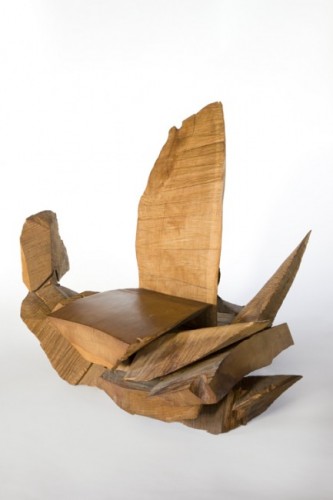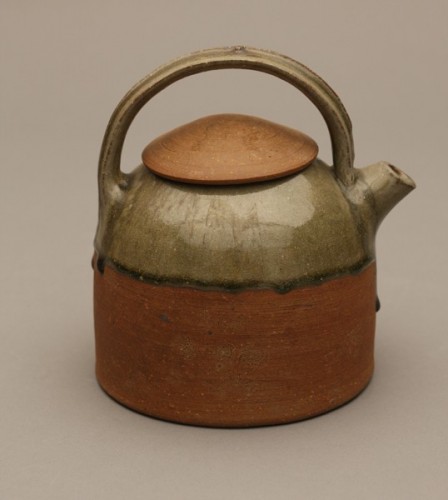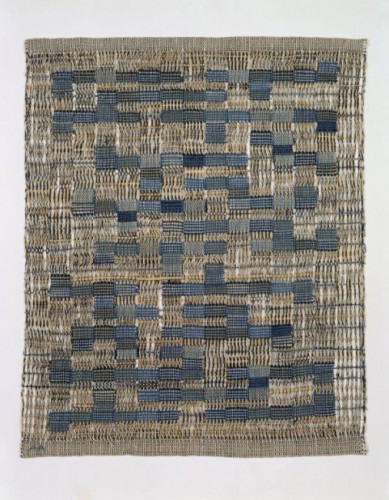A Pot by Any Other Name Is Still a Pot
Two exhibitions at the Museum of Arts and Design (MAD) spell out the contradictions that have finally surfaced at what used to be called the American Craft Museum — and before that the Museum of Contemporary Craft. Both names had incorporated the apparently now forbidden C-word.
The first of the exhibitions is “NYC Makers, The MAD Biennial” (running until Oct. 12), already effectively slammed elsewhere, but in ways that don’t approach the deeper meaning of this aesthetic catastrophe. The MAD Biennial attempts to survey a broad area of “making” and not craft or craft art, per se. But….
The second exhibition could be considered its alternative: “What Would Mrs. Webb Do? A Founder’s Vision,” to Feb. 8.
Back in 1956, after a string of other craft-oriented philanthropies (America House, The American Craft Council, The School of American Crafts in Rochester, and Craft Horizons magazine), Aileen Osborn Webb (1892-1979) founded the Museum of Contemporary Crafts. She had Vanderbilt blood, and like some others of her ilk she believed in good works, in her case supporting the crafts and helping them survive.
I myself descended into crafts because of the Patterning and Decoration Movement. Many of the P & D artists (e.g. Joyce Kozloff, Miriam Shapiro, Robert Zakanitch, Kim MacConnell…) appropriated craft and design traditions. So why not go directly to the source? I had already made it clear as a critic that I was in love with ceramics, therefore it was easy enough to also embrace wood, metal, fiber and glass, the other traditional craft materials. I was in search of whatever idealism I could find.
In 1993, I moved on to UrbanGlass, a gigantic glassblowing, glass-making nonprofit studio in downtown Brooklyn, and I was cured. Craft artists are the same as other artists. Underneath the gas-bagging of “art for the people,” they are presently as self-centered and ambitious, bless them, as painters or sculptors. Furthermore, craft collectors are not much different from painting and sculpture collectors. Both MAD and UrbanGlass have governing boards stuffed with collectors. They have the time and the money.
The once-humble craftsmen (ceramist, turner, weaver, woodworker, glassblower, metalworker, goldsmith) is indeed an artist, at least under the descriptive use of the word art. But philosophy, even Ordinary Language Philosophy, will always foul things up; so too will history. Before artisans and artists were differentiated in the Renaissance, lines of demarcation did not exist. Subtlety is always dangerous.
Is It Craft or Is It Spinach?
The paradox we are now stuck with can easily be illustrated. Most of the objects on display in the Webb show (from the American Craft Museum’s permanent collection inherited by MAD) were made by persons who did not think of themselves as artists with a capital A. The great ceramist Peter Voulkos (1924-2002) failed only when he tried to make metal sculpture.
Truly, most of the works in this neat historic survey of the American Craft Movement, now apparently in eclipse, were not created under the mantle of fine art, yet they now look surprisingly tasteful and occasionally beautiful — an early Wendell Castle (b. 1932) desk, a Paul Soldner (1922-2011) “platter,” an Otto Natzler (1908 – 2007) bowl, a Beatrice Wood (1893-1998) lusterware vessel, a weaving by Anni Albers (1899-1994). That cannot be said for most of the work in the MAD Biennial.
The Webb show might make you want to take up throwing clay on a wheel or making wooden furniture, or weaving. The MAD Biennial, taking up twice the space, will make you want to head for the hills. And I don’t mean summer craft schools like Penland or Anderson Ranch.
Democracy in Action
A lack of curatorial oversight ruins the first of what is to be a MAD Biennial foray, city-by-city all across America. Here in N.Y.C., so-called “makers” were nominated by a panel of 300 “cultural leaders” then pared down by a panel of 10 others, representing each of the five boroughs. This was a recipe for disaster. Here, we witness as many definitions of “makers” as the “cultural leader” nominators.
I am not totally against mixing up craftspeople, designers and sculptors. But even our ever-favorite Yoko Ono is included — in a slick multimedia presentation showing her making what looks like a traditional Japanese ink painting.
The show is tacky, wacky, fluffy and kitschy — technical terms I never use lightly. You are greeted by some overwhelming party decorations (?) made by the set-design company Confettisystem, covering the elevator wall of the Barbara Tober Atrium and a great deal of the Barbara Tober Staircase with paper, fabric and metal foil. I dare not enumerate much more, for the fifth and sixth floors are jammed with equivalent mistakes: almost sculpture, almost Conceptual Art, almost craft. Anything challenging or promising is buried under the conceptual cacophony. To make matters worse, wall labels have been eschewed, so you have to follow things through the use of a giveaway pamphlet. Most people I watched didn’t bother looking things up, they just zipped right through. The same thing was tried recently at a major show of paintings at MoMA. Please stop this phobia. Labels are your friends; if you don’t want to read them, you don’t see them. Trust me.
Craft Is Slow Art
In comparison to the MAD Biennial, much of the characteristically beige and strangely alien craft objects from the permanent collection looks luxurious, even thought-provoking. Visitors actually slow down to look at these now stately works that were chosen by experts in the field over a goodly number of years. Could it be that good work is produced only when, as in the past, tension among categories prevails?
When categories are broken or are ignored, arguments between materials and form and between use and contemplation disappear. When anything goes, nothing stands out, nothing is puzzling or challenging. Wit goes missing.
When employing the descriptive use of the word art (rather than the evaluative one) we may call many things art, but that doesn’t mean we can similarly call almost everything craft: bright red display-manikins, packing crates, computer tricks and pedestals. The issues are different.
The handout does not claim that all these efforts on display are examples of contemporary craft, but that is the effect. Eliminating the C-word does not fool anybody. MAD to most is still MOCC or ACM. I bet many people go there looking for craft, maybe even ceramics. Calling this institution MAD was a big, big mistake. Did someone think it was funny? Is the C-word such a turn-off? Did some marketing firm take a survey?
I personally know that certain craft collectors like to call what they collect sculpture, hoping that such a designation automatically makes their investments worth more. Really? A pot is still a pot. A desk is still a desk. A necklace is still a necklace. Art be hanged. We already have a Museum of Everything: The Metropolitan Museum of Art. The Met is full of ancient craft – armor, porcelain, ornate furniture, Greek pottery — and even sometimes contemporary craft, although two makers honored by the Met in recent times both prefer to be called artists or sculptors. Give me a break.
Until we see unapologetic contemporary craft exhibitions at MoMA, and at the Guggenheim, the Whitney, and The New Museum, there will still be a need for a contemporary craft museum in New York City. And not much need for a Museum of Almost Art or Not Quite Art.
The Future Was Yours
Although I mourn the sheathing-over of the original Edward Durrell Stone building MAD now occupies and think it a snore, short of stripping the building down and recreating those original Venetian columns and portholes, not much can be done. When it comes to museum architecture, maybe boring is good. Don’t the various expansions of MoMA prove that? Only architectural historians remember MoMA’s original Philip L. Goodwin and Edward Durrell Stone Bauhaus-inspired building. We are very nervous about Renzo Piano’s new Whitney building down at the edge of the old Meatpacking District. Please, please let it be boring, but good for looking at art.
At least under MAD’s new director Glenn Adamson, formerly of the Victoria and Albert Museum, the installation of the Biennial (with the exception of the lobby) looks relatively normal. You can breathe. Formerly it was the MAD installations that were cramped, not the spaces. I always wondered about that. The new spaces are not smaller than the old spaces of the building when it was Huntington Hartford”s Gallery of Modern Art, which showcased the A&P heir’s collection of Pre-Raphaelite kitsch. After five years, the building became the offices and the exhibition space of the N.Y.C. Department of Cultural Affairs. When I curated a show there, I found the spaces generous.
I am very happy too that at last Mrs. Webb’s good work is acknowledged. When I was employed at the American Craft Museum (1990-93) it sat across the street from MoMA. The registrar — who had been with the organization since the beginning of time — whispered to me that we still had Mrs. Webb’s desk in storage. I looked at it. It was handmade. I wanted it in my office, but I said we had better ask Janet Kardon, my boss, if she wanted it. “It is not big enough for me,” Kardon bellowed. It was big enough for me. So I was pleased to use the sacred item as my desk.
John Perreault is on Facebook, specializing in neo-modern, small-scale residential architecture.
Links here for John Perreault’s website & John Perreault’s art.
John Perreault videos: http://tinyurl.com/n6x848h






